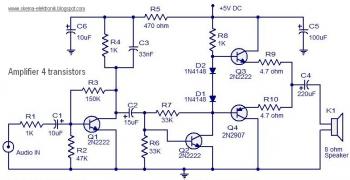A very simple and easy to construct class AB audio amplifier by using 4 transistors is provided right here. In class AB operation every output device performs more than half of the input signal cycle. As much as 78% efficiency is possible with class AB types and cross over distortion is minimized. The circuit shown right here is suitable for small radio receivers, audio players, intercom, phone and so on.
Transistor Q1 with its connected components is wired as a pre-amplifier place. The audio input is coupled towards the base of Q1 through resistor R1 and capacitor C1. Resistor R3 provides collector to base bias for Q1 and C3 is an AC by pass capacitor for the collector resistor R4. Collector to base biasing is really a good method of biasing for circuits like this because it provides enough negative feedback, prevents thermal runway and stabilizes the operating point. The second stage will be the driver stage for the push pull pair. Q2 with its connected parts perform this job. This stage is also collector to base biased, and its input is coupled to the output from the pre-amplifier stage using capacitor C2. Resistor R8 limits the collector present of Q2.The third stage will be the class AB push pull section comprising of transistors Q3 and Q4. Diodes D1 and D2 offers the bias voltage for the push pull stage. The output from the amplifier is coupled towards the loud speaker via the capacitor C4. C5 and C6 are voltage source / power supply filter capacitors.
Circuit Notes:
Circuit Notes:
- K1 can be an 8 ohm/5Wof loud speaker.
- The circuit may be assembled on a vero board.
- C6 should be grounded close to towards the Q1 and C5 must be grounded close to towards the loud speaker ground. This reduces noise.
- Use 5V DC for powering the circuit.

No comments:
Post a Comment